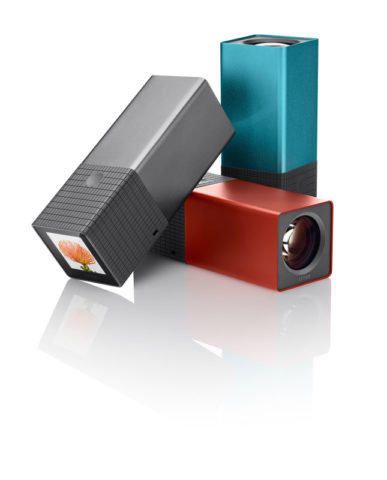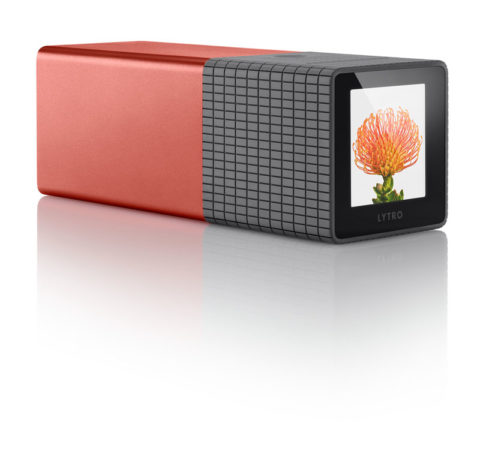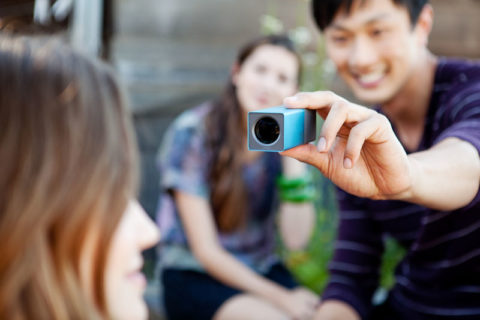Lytro Lightfield Camera: Just say no to focusing.
You know it’s fall when the camera press spins and spins on new camera after new camera. Sometime a while back Lytro, a newcomer to the market, had released a press release talking about their new camera design they were preparing to release. It’s finally come to fruition and while the technology is certainly novel and cool, though the camera appears less impressive form a UX perspective.
Capturing Lightfields not Images
In a traditional camera, the pixels on the sensor count photons that have been filtered to one of the 3 primary colors (red, green, or blue) laid out in a specific pattern. Then though some simple statistics, if you can say that about statistics, the two captured color values for every pixel can be reconstructed fairly accurately based on the values of the adjacent pixels. The result of this is that normal digital camera’s capture an image, in focus areas are in focus, out of focus areas are blurred and can’t be reconstructed.
What Lytro has done is (and you’ll have to pardon me because the physics is slightly beyond my grasp I don’t have a PhD in optics) is added a second set of micro lenses in front of the normal lenses. The first set of lenses, break the image down in such a way that the sensor itself captures in focus light at what amounts to every focus position. Then using even more clever than normal processing, an image can be reconstructed so that focus can be placed anywhere in the scene and depth of field can be simulated.
As a result of this, the camera doesn’t need an AF motor or a variable focus lens. Ultimately presenting some interesting implications for simplifying lens design.
The catch to all this is that the sensor that captures the data operates at a fraction of it’s “normal” resolution. For example the Lytro prototype camera used a 16.7 MP capture sensor, but could only produce 296×296 pixel images. The final production model Lytro camera uses an 11 megaray sensor (I’m assuming this amounts to ~ 11MP in terms of sensing pixels) which appears to produce an 1080×1080 pixel image.
Specs
The specs as published are, unfortunately somewhat pathetically in my eyes. I’ve listed the most interesting ones below, to read the full specs you can visit Lytro’s site.
| Storage | 8GB or 16GB fixed internal storage (capacity of 350 and 750 images respectively) |
| Lens | 8x optical zoom with constant f/2 aperture |
| Display | 1.46 inch, touch sensitive backlit LCD |
| Controls | Power button, shutter button, zoom slider, touchscreen |
| Exposure Controls | Tap touchscreen to set |
| File format | Light field picture file (.lfp) |
| Dimensions | 1.61 in x 1.61 in x 4.41 in | 41mm x 41mm x 112mm |
| Weight | 7.55 oz | 214 g |
| Battery | Non-removable built in Lithium Ion battery |
Now for a guess. Lytro has been quiet on what the lens actually is, though they do have an cutaway view on their site. I’ve taken the time to measure that in Photoshop, and while not the most accurate way of doing things, this is my guess as to what the lens and sensor are.
The lens appears to be a 7-56mm f/2, that would be equivalent to a 35-280 lens on a 35mm/full frame/FX SLR. The main lens’s depth of field, and I think as a result the smallest DoF the system can image, is equal to shooting at an aperture of f/10 on 35mm over the noted focal lengths. The sensor appears to be about 6mm tall resulting in a crop factor of about 5x.
Thoughts
While the technology looks and sounds very impressive. I’m clearly not the target market. Moreover, the ergonomics of the product, at least as it appears to me, fall somewhat short.
As seen in the image above, the only real workable way to use the camera is to hold it out in front of you, similar to how you use a Point and Shoot or camera phone. That is, at least, if you care about composing the image you’re going to shoot. I’ve never been a fan of this as it makes for all that much less stable of a shooting position. Though if there’s one thing going in Lytro’s favor, it is fairly light and may be balanced fairly well if the battery is heavy enough and the lens light enough.
One thing that may have gone a long way to helping me see the ergonomics of it, would be a rotating LCD. If you could flip the LCD up on top, the camera could be held like a SLR with a waist-level finder. In black or dark gray, with that configuration for the LCD and the shutter release on the side, the camera would make a very nice platform for street photography, especially with there being no need to focus.
That said, while small, it’s an odd shape that’s not exactly pocketable in the same way a compact P&S or cellphone is.
The biggest problem I see is a combination of lack of support for the image format and the need to post processes to get something ubiquitously viewable. The lightfiled files are simply not something that can be downloaded, and emailed to grandma like JPEGs off a P&S. Lytro has an online storage service for the system, and that’s something of a workaround to that issue, but it’s not perfect. It’s also worth nothing that, at the time this was written, their ToS has a rights grabbing license clause in it.
Moreover there’s no baked in support for the format anywhere. JPEG is ubiquitous, it’s supported in every phone, computer, and most importantly digital picture frame that the all important grandparents have because they don’t have a computer. In fact, in that respect, I’d say they’re already failing. Lytro launched the camera without native Windows support. That alone is a good way to alienate, or at least delay, access to more than 90% of the computer using public.
The thing that I really wonder about is how well this will go over in the consumer market and for how long. As I see it, the ability it offers is little more than a novelty, and the price to get it is quite steep. How interesting is exploring an image going to be, when most images lack any more than a single subject to start with? Finding and composing images that will be interesting to maneuver focus around is going to be considerably harder than making interesting images that only have one subject–and that’s already hard enough for most people. How often will you really want to move the point of focus? For that matter, depth of field, or limited depth of field, is a major creative element that enables the photographer to single out some specific element in the scene and direct the viewer’s attention there.
Finally there’s the question of resolution, if the images really are about 500×500 pixels, that’s not really suitable for printing, or for that matter viewing a 300 DPI display it will be quite small (~1.6″ square). Even on normal ~100 DPI displays, you’re still talking about a 5×5 inch image that won’t have near the sharpness of a 4×6 drugstore print.
After further research, it appears the images are 1080×1080, which while better than 500×500 is still not that great. A 300dpi print for the photo album would be 3.6″ square, still not quite a 4×6 but not nearly as bad as I had it first appeared to be. Then again, the 1080×1080 full resolution images posted on Lytro’s site aren’t exactly stellar when it comes to sharpness. While that may be a result of preproduction hardware, I can’t say I’m all that impressed if that’s what they’ll actually end up looking like.
As much as I love cool tech, it’s clear to me at least, that I’m not the target market for the Lytro Lightfeild Camera. I’m already bored with the novelty of moving focus around, and I’ve only played with the images on Lytro’s site for a few minutes. Moreover, I don’t really see many regular photographers making images that are both compelling and have multiple layers of interest that you can shift focus through when so many have a hard time doing that when there’s only one subject. At best they’ll have multiple layers of nothing very interesting, at worst there will be no point in moving the focus around.
If there’s one thing I’d like to make a note of, that’s the difficulty of finding what I think most photographers would consider basic information. Lytro doesn’t even give a hint towards what the focal length or field of view might be, and you’re really left guessing what the “JPEGable” image sizes are.
I sincerely wish Lytro luck, they have some seriously cool innovative tech on their hands and a completely different approach to what a camera should be. Moreover, I can see a few novel but very interesting applications of the technology in things like video and especially 3D. I just don’t know if it has any real staying power in it’s current market and implementation. Then again, maybe I’m wrong.
Press kit images courtesy of Lytro, Inc.


